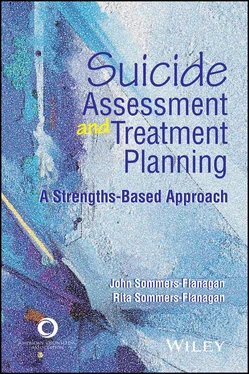John Sommers-Flanagan - Suicide Assessment and Treatment Planning
Здесь есть возможность читать онлайн «John Sommers-Flanagan - Suicide Assessment and Treatment Planning» — ознакомительный отрывок электронной книги совершенно бесплатно, а после прочтения отрывка купить полную версию. В некоторых случаях можно слушать аудио, скачать через торрент в формате fb2 и присутствует краткое содержание. Жанр: unrecognised, на английском языке. Описание произведения, (предисловие) а так же отзывы посетителей доступны на портале библиотеки ЛибКат.
- Название:Suicide Assessment and Treatment Planning
- Автор:
- Жанр:
- Год:неизвестен
- ISBN:нет данных
- Рейтинг книги:4 / 5. Голосов: 1
-
Избранное:Добавить в избранное
- Отзывы:
-
Ваша оценка:
- 80
- 1
- 2
- 3
- 4
- 5
Suicide Assessment and Treatment Planning: краткое содержание, описание и аннотация
Предлагаем к чтению аннотацию, описание, краткое содержание или предисловие (зависит от того, что написал сам автор книги «Suicide Assessment and Treatment Planning»). Если вы не нашли необходимую информацию о книге — напишите в комментариях, мы постараемся отыскать её.
Suicide Assessment and Treatment Planning — читать онлайн ознакомительный отрывок
Ниже представлен текст книги, разбитый по страницам. Система сохранения места последней прочитанной страницы, позволяет с удобством читать онлайн бесплатно книгу «Suicide Assessment and Treatment Planning», без необходимости каждый раз заново искать на чём Вы остановились. Поставьте закладку, и сможете в любой момент перейти на страницу, на которой закончили чтение.
Интервал:
Закладка:
Getting Ready
Despite rising rates, death by suicide is a rare event (about 14 to 15 deaths per 100,000 people in the United States in 2018; American Foundation for Suicide Prevention, 2020). However, early and often throughout your career, you are likely to see many students and mental health clients who struggle with suicidality (Binkley & Leibert, 2015; Roush et al., 2018). Being ready to respond competently and calmly to suicidal thoughts and impulses is essential. As Joiner (2005) wrote, “Suicide is an urgent issue—it kills people—but urgency need not entail panic” (p. 17). Becoming and remaining competent is your best antidote to panic.
Practical Realities
Often, as in the case of Alina, concerns about suicide emerge partway into a session, even though suicidality was not the primary reason for the referral or meeting. Other times suicidality will be the immediate issue demanding your focus. In still other scenarios, your client will not mention distress or suicide until near the end of the session, leaving you with very little time to deal with a very big issue.
As you develop competence for handling suicide scenarios, at a minimum, you have your own attitudes and values to examine; assessment skills to learn, practice, and memorize; professional and ethical responsibilities to manage; intervention strategies to consider; and many other competencies to acquire and fine-tune. No wonder this is a stressful domain for most counselors. If thinking about these responsibilities causes you anxiety, you are not alone. Most health and mental health care professionals rate suicide assessment, management, and treatment planning as one of their greatest stressors (Binkley & Leibert, 2015; Maris, 2019). When clients talk about suicide, it is natural to begin worrying about a range of issues, including potential hospitalization and your responsibilities for keeping clients and students alive.
Increased suicide rates have translated into increased demand for competent professional assessment and treatment services. Unfortunately, suicide assessment and treatment competencies have not been systematically integrated into the training curricula of students in counseling, psychology, social work, nursing, and psychiatry (Cramer et al., 2013; Granello, 2010a; Morris & Minton, 2012). This lack of systematic training in suicide assessment and treatment has relevance for you and your practice. Along with most of the mental health and health care workforce, you may feel uncertain about suicide assessments, unclear about how to develop suicide-specific treatment plans, and uninformed about research-supported interventions for clients and students who are suicidal.
Before reading further, take a moment to check in with yourself. You know that this is a book about suicide assessment and treatment planning, but even that obvious fact deserves reflection. Although we are taking a positive, wellness-oriented approach, content in the following pages and chapters can and will be activating. You will find yourself reacting to the material.
In many places, we write about suicide directly, using actual and constructed suicide cases as well as composite and hypothetical suicide scenarios (note that identifying information is removed or modified to protect confidentiality). Our purpose is to prepare you to work in counseling situations in which suicidality is a concern. We write about suicide in provocative ways for several reasons:
1 You never know whether or when your next client or student will be suicidal. We believe that you can and should be prepared to address suicide and suicidality with competence and confidence.
2 Competence begins with understanding your own attitudes, beliefs, and values. Throughout this book, we will intermittently ask you to check in with yourself and to notice, accept, and manage your thoughts, emotions, and behavioral impulses.
3 Working with clients who are suicidal is emotionally activating. Becoming comfortable with suicide as an issue in counseling is a developmental process that takes time and practice. One way of looking at the content of this book is as an exposure experience that will improve your ability to self-regulate when facing crisis situations as a counseling professional.
If your goals are to become comfortable, confident, and competent when working with clients who are suicidal—and we hope these are your goals—your best route is to strengthen your professional suicide assessment and treatment competencies. Rigorous and direct exposure to suicide-related material in this book and others, along with workshop training and supervision, will get you on track toward professional competence in suicide assessment and treatment.
In the end, we want you to know—in your head and in your heart—that you have the knowledge and skills to provide effective suicide assessment and treatment. Having confidence in your knowledge and skills will be emotionally stabilizing; it will also help you develop a positive and optimistic attitude toward suicide intervention and prevention that you can then pass on to your clients and students.
Emotional Responses to the Topic of Suicide
We began facilitating workshops, lectures, and trainings on suicide assessment and intervention in the 1990s. One presentation stands out. We asked about 80 school and mental health professionals, “How many of you have worked with clients or students who are suicidal?” Nearly everyone raised their hand. We followed up with, “How many of you have worked with a client who died by suicide?” About 15 hands went up. We asked how many had faced more than one client death by suicide; a few hands hesitantly went up. After thanking the group, we shared our own experiences and then transitioned to talking about coping strategies for professionals when clients complete suicide.
While talking, we noticed activity in the back of the room. Rose, a colleague we knew well, stood up and slipped out. Rose was a licensed mental health professional, an unflappable woman with a reputation for working with the toughest teens in town. We did not make much of her exit, but later Rose contacted us. “Sorry about leaving. You got to me. When you started talking about clients dying, I had to get out. I’ve had too many. Maybe I haven’t dealt with some of my losses.”
Regardless of your experience, suicide is a difficult topic, and emotional reactions run deep. Your own reactions may link to values, religious beliefs, losses, or future fears. Maybe you have had a friend, client, or family member die by suicide. In such situations, waves of painful emotions might come up whenever suicide is mentioned. Or you may struggle with suicidal thoughts yourself. No matter your background, conversations about suicide will activate or trigger your unique emotional response. Gaining experiences can reduce the intensity of your emotional responses to suicide scenarios, but there is also a chance it might magnify them. Either way, recognizing and having a plan for coping with your emotional responses will make you a more competent, ethical professional (Corey et al., 2018).
Professional Self-Care
Rose left the suicide workshop after recognizing that her emotional bucket was full. She stopped listening and removed herself from the room. She realized that she needed to take care of herself. We recommend that as you read this book and work with people who are suicidal, you weave lifestyle strategies for managing the input of stressful information into your life.
Stop Reading
Be sure to follow Rose’s example and stop reading if you need to. During suicide workshops and college classes, we tell people that to avoid being triggered, they can do what our teenage clients do: Just stop listening to us. Suicide information overload happens. One method for dealing with overload is to stop the input, step back, and take time to absorb and regroup.
Читать дальшеИнтервал:
Закладка:
Похожие книги на «Suicide Assessment and Treatment Planning»
Представляем Вашему вниманию похожие книги на «Suicide Assessment and Treatment Planning» списком для выбора. Мы отобрали схожую по названию и смыслу литературу в надежде предоставить читателям больше вариантов отыскать новые, интересные, ещё непрочитанные произведения.
Обсуждение, отзывы о книге «Suicide Assessment and Treatment Planning» и просто собственные мнения читателей. Оставьте ваши комментарии, напишите, что Вы думаете о произведении, его смысле или главных героях. Укажите что конкретно понравилось, а что нет, и почему Вы так считаете.











